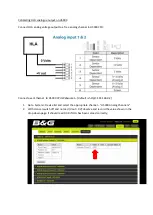
7
H i s t o r y o f t h e V T - I / F Va c u u m T u b e
I n s t r u m e n t I n t e r f a c e
As far back as I can remember, taking instruments “direct” has never sounded
very good to me. There always seemed to be a lack of dynamics, and a sterile qual-
ity to sounds recorded with a direct box (or DI).
Frankly, initially I was not very excited about designing the VT-I/F. I assumed
that the lifeless sound I was accustomed to was the nature of direct sounds.
Before beginning the design of the circuit, I spoke to a number of engineers,
producers, and musicians about what they felt was lacking in DI boxes. Almost
without exception, they all said, “It’s got to have tons of headroom.” How much
headroom was enough? I spoke to a number of instrument pickup manufacturers
and got an idea of the peak output level of a variety of instruments. These figures
were confirmed with an oscilloscope placed directly across the output of various
electric guitars, basses, pianos, synthesizers, etc.
The first design goal was to accommodate the full dynamic range of sources
likely to be connected to the VT-I/F. Secondly, the design had to be quiet. After
that, it was just a matter of designing it to have the type of performance and pack-
aging that audio professionals have come to expect from our VT-1/VT-2 Vacuum
Tube Microphone Preamplifiers.
The decision was made early on that the output of the VT-I/F would be at micro-
phone level. Although a line-level output is not difficult to design, it would
increase the cost. Besides, everyone has mic preamps available. Although the VT-
I/F will work with virtually any mic preamp, it was designed to complement the
VT-1/VT-2 series of preamps.
We tried the first prototype on a solid-body electric guitar, and compared the
sound to several other respected DI boxes. We were astonished at first listen! It
sounded very close to the sound of the guitar through a good vacuum tube amp.
This prototype was evaluated by a number of studio friends, who made some
useful suggestions. These suggestions were incorporated into the second proto-
type, and the VT-I/F design was complete. By the way, our evaluators were very,
very reluctant to return the prototype.
Содержание VT-I
Страница 1: ...VT I F Vacuum Tube Instrument Interface D W FEARN Operating Instructions...
Страница 9: ...VT I F Vacuum Tube Instrument Interface D W FEARN 10...
Страница 18: ...20...







































